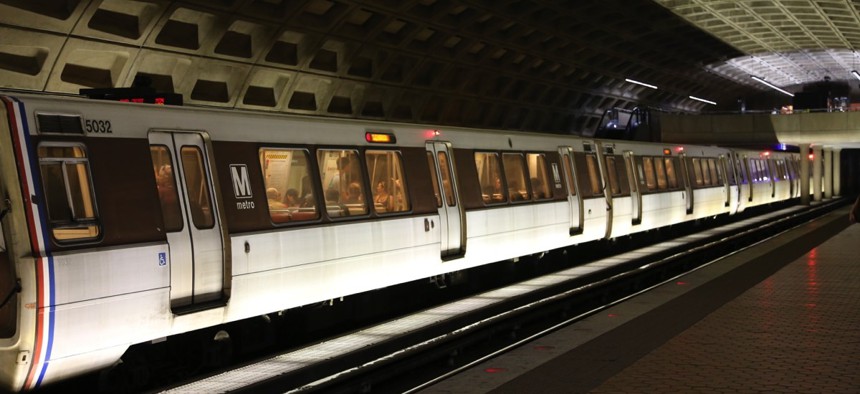Cities Are Embracing Resilient, Equitable Infrastructure Finance Out of Necessity

Washington, D.C. metro

Connecting state and local government leaders
Climate change is putting increased pressure on often-chronically underinvested and already failing systems, forcing municipal agencies to experiment with new funding mechanisms.
Cities are adopting infrastructure finance innovations at historic rates due to rapidly growing private, philanthropic, and impact investing resources and the creation of new, data-driven investment models, according to a City Accelerator report released Wednesday.
The high-profile deterioration of U.S. water, stormwater and transit infrastructure, in particular, has municipal infrastructure agencies attempting to reverse the cycle of underinvestment in the face of costly overhauls and climate change.
Pittsburgh; Saint Paul, Minnesota; San Francisco and Washington, D.C. joined City Accelerator’s 18-month infrastructure finance cohort to evaluate much-needed capital project delivery strategies like pay-for-success bonding, public-private partnerships and energy savings agreements. The initiative was led by Living Cities and solely supported by the Citi Foundation.
“We really don’t have a capital problem,” Jen Mayer, the report’s author and cohort leader, told Route Fifty by phone. “We have a revenue problem.”
Finding diverse revenue sources to pay an initial capital investment back is a challenge that should be addressed up front with infrastructure projects. Ribbon cuttings are great, but not when a city’s capital budget blows away its operating budget.
Mayer recommends the people assembling capital projects adopt a longer-term view than they’re traditionally used to, to avoid structural deficits the likes of which have created death spirals with the New York City subway and D.C. metro when coupled with unsustainable neglect. Cities must link their capital and operating budgets in strong ways so that, for example, investing in a signal system out of the capital side reduces costs on the operating side.
D.C. has recognized most of its land value is within a quarter mile of its metro stations, and yet little of the resulting revenue supports metro infrastructure. The city is now thinking of ways to recapture that value, as a result of the cohort.
When P3s are involved, cities should look to transfer key risks to the private sector, according to the report.

The service infrastructure provides is another lens with which to look at operating and capital budgets and identify innovative, workable models that build resilience—like backing up levees with green infrastructure that reduces flood risk and thereby damage costs.
“A lot of cities are facing climate and resilience challenges, and you don’t see a lot of action from the federal government in the short term on that,” Mayer said. “I think the next wave of the future is investing in capital projects that boost resilience.”
At the finance level, cities are looking to avoid costs associated with sea-level rise and resulting damage by constructing infrastructure and then calculating the resulting savings from spending that initial “protection money,” as Mayer calls it.
A third finding was one of systemic inequity, according to the report:
”For nearly nine decades, redlining and other inequitable credit policies were reinforced by infrastructure development policies that ignored the needs of already-disadvantaged communities. Redlining kept urban neighborhoods poor; transportation infrastructure isolated them and other infrastructure projects polluted them. These factors were a one-two punch that combined to create persistent patterns of poverty in many urban areas. Yet the infrastructure projects that used to reinforce inequity can also help reverse it. Equitable financial strategies can help return some of the public equity—the value created by infrastructure development—to the people and communities where it occurs.”
Job creation, workforce development, support for affordable housing, increased health clinics and public spaces, and transportation accessibility all stem from equitable planning.
“Equity used to be a box that you would check at the end of a project,” Mayer said.
Taking things a step further, community land trusts and limited-equity housing cooperatives can protect residents from falling being priced out of town by gentrification. In D.C., for instance, the 11th Street Bridge Park project has generated enthusiasm around preserving nearby residents who might otherwise be displaced in its aftermath.
Alaska ensures its citizens receive a portion of the revenue from the extraction of its natural resources, and community dividends from local infrastructure are another option that work much the same way.
Cities should engage a variety of stakeholders before and during the project for financing feedback to ensure success and equity, according to the report.
Mayer lived in San Francisco for 17 years but didn’t know the city had a seawall, one that would allow the flooding of many low-income areas should it fail, for much of that time. Most cities have critical infrastructure residents aren’t aware of but should be informed of, Mayer said, and that requires public engagement because civil engineers tend to do their jobs quietly.
Getting more people at the table when designing projects takes longer but delivers a result that serves more needs, a process known as “multisolving.”
“As land gets more tight, you’re going to need more infrastructure projects that do a lot more things,” Mayer said. “That’s not what our capital planning and funding systems are designed for.”
Dave Nyczepir is a News Editor at Government Executive’s Route Fifty and is based in Washington, D.C.

NEXT STORY: Environmental Review Law Faces GOP Scrutiny in U.S. House





